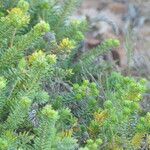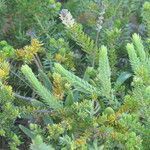Shrub or dwarf shrub, up to 1.2 m high. Leaves 2.5-8.0 mm long, alternate, spreading or reflexed, oblong-or ovate-lanceolate, ovate or sometimes cordate, acute or obtuse, with a slightly recurved awn-like mucro, glabrous, glands usually confined to margins. Flowers in terminal clusters, white; bracteoles absent. Sepals 1.5-3.0 mm long, glabrous. Petals 3.5-4.0 mm long, blade obovate; upper surface puberulous, ciliolate at base; claw almost as long, linear-oblong, puberulous above, ciliolate. Staminodes 2.5 mm long, linear, acuminate, gland-tipped, ciliolate. Ovary with many, long-stalked glands on upper half, with 3 carpels with rotund processes; style glabrous. Flowering time Apr.-Jan. Fruit reticulately ridged, with linear-oblong processes. Fruit reticulately ridged, with linear-oblong processes.
Densely leafy shrublet to 1.2 m, strongly sulphur-smelling, leaf tips spiny. Flowers in terminal clusters, white. Fruits 3-chambered.


